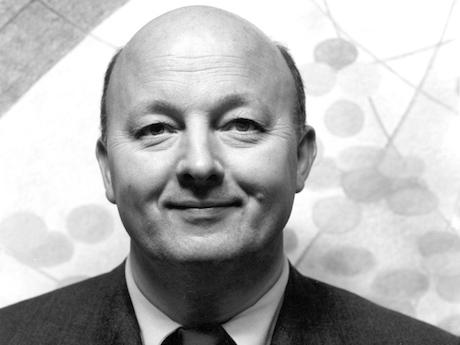Oskar Fischinger: Google Doodle salutes animation pioneer the Nazis couldn’t stop
'Each time I watch his films, I get lost in the incredible choreography of shapes and colour'

Your support helps us to tell the story
From reproductive rights to climate change to Big Tech, The Independent is on the ground when the story is developing. Whether it's investigating the financials of Elon Musk's pro-Trump PAC or producing our latest documentary, 'The A Word', which shines a light on the American women fighting for reproductive rights, we know how important it is to parse out the facts from the messaging.
At such a critical moment in US history, we need reporters on the ground. Your donation allows us to keep sending journalists to speak to both sides of the story.
The Independent is trusted by Americans across the entire political spectrum. And unlike many other quality news outlets, we choose not to lock Americans out of our reporting and analysis with paywalls. We believe quality journalism should be available to everyone, paid for by those who can afford it.
Your support makes all the difference.To view the mesmerising art of Oskar Fischinger is to hear it, and to listen to one of his films is to see it. In his hands, sight and sound engage in a hypnotically magical dance, till geometry seems to beat like biology, pulsating with the very stuff of life.
As the great abstract animator himself put it: “There exists a music of the visual world.” And today, Google lets you create your own marriage of colour and cadence.
Thursday’s interactive home-page Doodle celebrates the pioneering artistic achievement and lasting influence of Fischinger, who would have turned 117 today. Google’s playful art lets you choose notes that spark shapes in quick, looping tribute.
The creative lead on the Doodle was Leon Hong, who is fascinated by how the German-born animator created such boldly inventive films nearly a century ago, without the modern aid of digital tools.
“Each time I watch his films, I get lost in the incredible choreography of shapes and colour,” Hong tells The Washington Post’s Comic Riffs. “He truly had a unique ability to give abstract objects incredible personality and character, all meticulously synced to every emotional detail and cadence within a musical accompaniment.”
Fischinger would sometimes paint on Plexiglass, painstakingly shooting a frame to record every brushstroke or geometric move — and his work was sometimes set to such composers as Liszt and Bach.
Hong, who is riveted most by the movement within Fischinger’s films, recounts his introduction to the animator’s work.
“Never before had circles and lines made me smile, laugh and stare in awe,” the Google artist says. “To inject so much life in such simple graphic elements is a magical feat — his intuition with timing, anticipation and exaggeration was second to none. Each individual frame was carefully designed.
“Most surprisingly of all, his works were accomplished half a century before the advent of motion-graphics software and the mathematical easing equations that every modern designer takes for granted,” Hong continues. “And despite the incredible assistance of digital tools of today, the endless amount of motion graphics we see every day on TV and digital media still don’t come anywhere close to the greatness of Oskar Fischinger.”

Watch Apple TV+ free for 7 days
New subscribers only. £8.99/mo. after free trial. Plan auto-renews until cancelled

Watch Apple TV+ free for 7 days
New subscribers only. £8.99/mo. after free trial. Plan auto-renews until cancelled
The abstract animator, who was born near Frankfurt in 1900, first launched into a music career, practicing violin and studying organ building. During World War I, he learned architectural drafting, and by 1921 he was profoundly influenced by Walther Ruttman’s musically scored abstract film Lichtspiel Opus 1.
Fischinger’s abstract experimentation spiked in the 1920s, as he began creating highly popular shorts that employed multiple film projectors and slide projectors — even as he alternated between personal and commercial projects, including effects work for Fritz Lang.
His brilliance in the ’30s — including mastery of three-colour film — ran headlong into the rise of Hitler, as Nazi Germany declared such abstract art “degenerate.” So by 1936, he headed to Hollywood, working for such studios as Paramount, MGM and Disney, though the creative constraints — including the editing of his Bach sequence for Fantasia — proved very trying for the artistic genius.
Fischinger, who turned heavily toward oil painting in his last decades, died in 1967 in Los Angeles — where the Center for Visual Music now archives his work.
His brilliance has inspired generations of artists, including composer John Cage.
“Maybe it’s impossible to deny true talent, and so it stands the test of time and will continue to do so,” says the animator’s youngest daughter, Angie Fischinger. “I am incredibly happy that his work is an inspiration to other creative minds. Talent like his and his inability to deny its expression is what have art critics acknowledging Oskar as ‘ahead of his time.’”
Angie Fischinger worked with Google on today’s salute to her father — a Doodle that also tapped the talents of engineers Kris Hom and Brian Murray and producer My-Linh Le.
“I think he continues to inspire,” Fischinger’s daughter says, “because we have greater tools to work with [computer graphics] — that allow the creative minds to think about taking his ideas to a higher expression.”
The Washington Post
Join our commenting forum
Join thought-provoking conversations, follow other Independent readers and see their replies
Comments